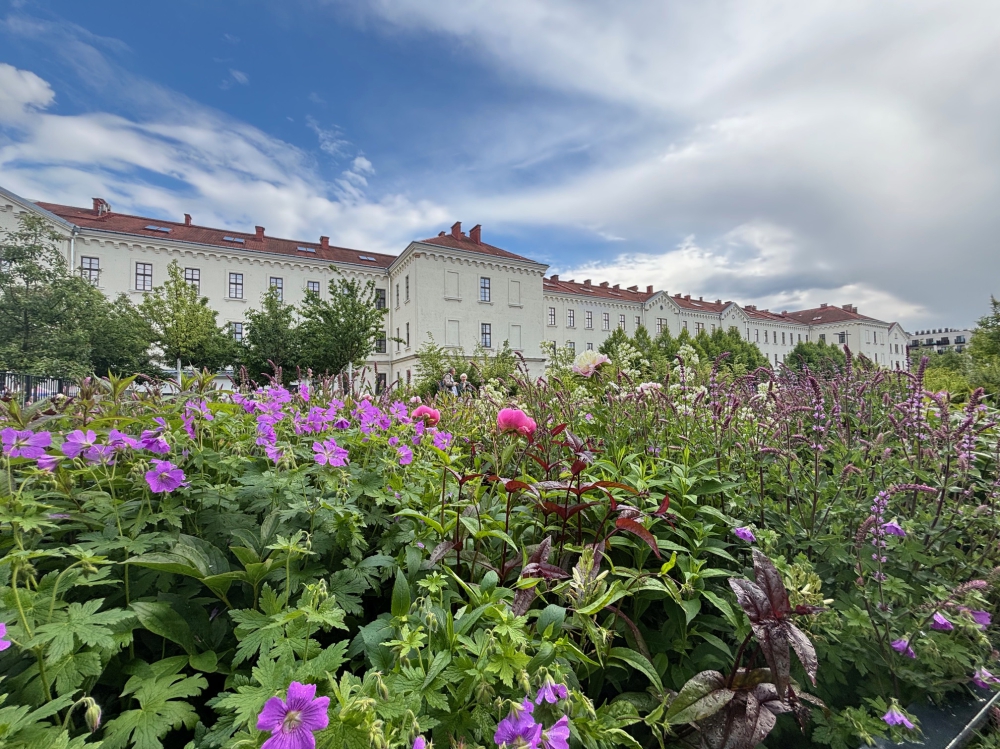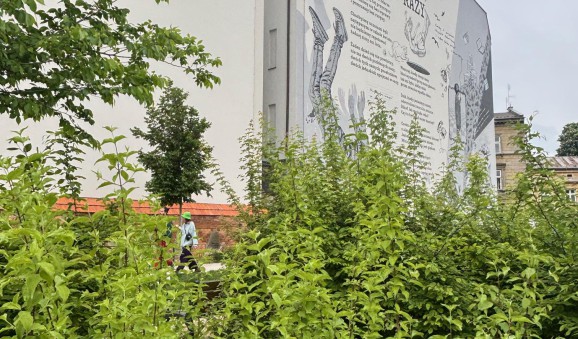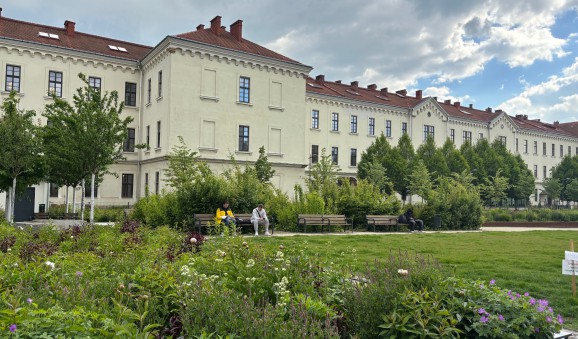- HOME >
- NEWS >
- Cultivation 07-11-2025
Greenery instead of statue

The Wisława Szymborska Park in Krakow, Poland is an example of a green space which, although small, has dramatically changed a part of this historic city – in the centre, where the price per square meter of land is enormous. It is also an example of the success of urban activism and the advantage of participatory projects, in which residents have the decisive vote.
Two years after the opening of this enclave, dedicated to the famous Polish poet and the winner of the Nobel Prize in Literature (1996), there is no doubt that the Szymborska Park will make a landmark as one of the most renowned green investments of the early 21st century in Kraków. For now, as a young setting, it is more like a garden, which will ‘mature’ year by year, increasing the volume of greenery and providing more and more shade.
Nobel Prize winner prefers green
The Wisława Szymborska Park is located at 24b Karmelicka Street, just 600 meters from the very center of Krakow, i.e. the Main Market Square, which is the city's showcase. It covers an area of 0.8 hectares. It was opened on July 2, 2023, on the 100th anniversary of its patron’s birth, as a ‘monument’ to Wisława Szymborska – a famous and beloved resident of Krakow (where she lived from 1929 until her death in 2012). This memorial to the Nobel Prize winner was in tune with her philosophy of life, which is expressed in the verses of many of her poems, such as the one entitled “Possibilities,” where we read, among other phrases: “I prefer the color green.” The dedication of the park (garden) to the poet was also compatible with the identity of Krakow – the UNESCO City of Literature.
Citizens’ battle for greenery
For a number of years, urban activists from Krakow had been campaigning hard for this green space – eventually, the project entitled “Yes to the park in Karmelicka St.” proved to be the most popular municipal project within the 2019 Citizens’ Participatory Budget in Kraków and, in accordance with the rules, moved it into the implementation stage. It turned out to be a spectacular example of efforts aimed at improving not only the visual appeal of the agglomeration, but also the comfort of living in the centre of this touristic city. “We must ensure that people do not move out of the centre completely, because otherwise it will only become a place for short-term rentals, ‘free’ of Krakow residents”, was one of the strong arguments.
The garden-park was created on the premises of a provisional car park that had existed for a number of years. Historically, in the 19th/20th century (when Poland was still under partition and its southern part belonged to the Austro-Hungarian Empire), there was a roll-call square on this site, which was a part of the military barracks of Emperor Franz Joseph I. In modern times, in the 1990s, the square – a piece of land with an unusual location and high value, coveted by developers – was sold by the Municipality of Kraków and ended up in the hands of two subsequent investors (the second one, Irish, did not pay the land tax and in 2012 lost the plot, which in consequence returned to the Municipality).
Connecting history with present era
The park was designed by the Polish studio Gajda Architektura Krajobrazu, in collaboration with the foreign architectural studios – Charlie Hussey from Edinburgh (UK) and Heiner Luz from Munich (Germany).
The main challenge was to adapt the park to the diverse context of its surroundings and to refer to the history of the place (the very centre of Kraków is listed in the register of heritage sites). At the same time, it was necessary to align the character of this green area with its patron, the well-known poet. With such a small area, the designers also had to meet the various expectations of the residents of Kraków, whose representatives kept their fingers on the pulse and were in constant touch with the City Greenery Office of Kraków (the direct commissioner of the project).
The authors of the project also had to take into account contemporary challenges, such as climate change and the need to select plants that are resistant to the deteriorating urban conditions, as well as implement biodiversity.
Secret garden accessible to everyone
The construction of the park began at the end of 2021 and lasted approximately 1.5 years. The cost of the project amounted to over PLN 9 million (at present – over €2,1 million). It is located in the 19th-century district, beyond the former military building (currently housing the Public Library – adjacent to the park), and near the monastery of Carmelites, on the opposite side of the Karmelicka Street. The general idea behind the project was to create a ‘secret garden’, an oasis in the city – a place of relaxation and contemplation, accessible to everyone, regardless of the age, including the disabled as well as the partially sighted people.
The park was created as a sequence of intertwining garden interiors, each with its own unique character and connection to its closest surroundings. The solutions refer to the historical uses of the area, including those from before 19th century. It has five entrances, the main one – in the Karmelicka Street (the other big gate is located opposite, in the parallel Rajska St.). On its entering, one passes through the ‘orchard’, which refers to the Carmelite orchards, and then can continue along a curved path through the floral meadows, inspired by the open fields that once existed in this area. The lawn in the central part of the setting is a green reference to the roll-call square of the military complex. At the other end of the park, a small grove was created, reminiscent of the suburban forests. Red, Green, Yellow and Blue sensory gardens feature the perennial beds, including bulb plants. They reflect the enclosed gardens between the blocks of buildings of Kraków’s Old Town. The plant species have been selected to provide a varied effect throughout the entire season.
Green-blue infrastructure
The park would not be complete without water, which flows through a system of canals and ponds along the main lane, lined with lime trees. It refers to the former drainage canals and fish ponds that once existed in this part of the town. This element of the park has made it possible to introduce aquatic plants, such as water lilies, for example. Rainwater retention from the area of the park and from the roof of the neighbouring Library has been implemented, as well as natural filtration.
Biodiversity
The greenery includes over twenty species of trees, nearly twenty species of shrubs and a rich variety of perennials, many of which are fragrant. In total 125 trees were planted, including hornbeams, lime trees, oaks, maples, as well as less commonly used species like Corylus colurna or Ostrya carpinifolia. The fruit trees comprise apple, pear, cherry, sweet cherry and plum trees. Among the more than 1,500 shrubs are Sambucus nigra, Syringa vulgaris, Viburnum opulus, Hydrangea quercifolia, Amelanchier lamarckii, Calycanthus floridus, roses and many others. As many as 18,500 different perennials were used, including popular ones, such as Geranium, Hemerocallis, Paeonia or Phlox, as well as the less-known ones, such as Baptisia and Selinum. Almost 80,000 flower bulbs were planted too.
Poetically
In the park dedicated to Wisława Szymborska, a visitor can, to the rhythm of her poems: experience the joy of reading (perhaps books borrowed from the neighbouring library), lie on the grass and admire the clouds parading above us, talk to a stone or listen to the silence of plants, remember that ‘Nothing can ever happen twice’ (this most famous Szymborska’s quote and poem appears on a mural on the wall of the building at 28 Karmelicka Street, adjacent to the park). Many other artefacts associated with the poet have been incorporated into the green enclave, such as Corten steel letters with fragments of the aforementioned poem ‘Possibilities’ or interactive installations that allow for intelligent games.
Author and pictures: Alicja Cecot


